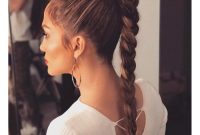In the pursuit of sleek, straight locks, permanent straightening treatments have emerged as a popular choice. These treatments offer a long-lasting solution to tame unruly curls, waves, and frizz. However, with a myriad of options available, deciding on the right permanent straightening treatment can be a daunting task.
This comprehensive guide delves into the world of permanent straightening, providing insights into the different types, factors to consider, and essential pre- and post-treatment care.
Permanent straightening treatments work by altering the hair’s structure, breaking down the bonds that give it its natural curl or wave pattern. The result is straighter, smoother hair that can last for several months. There are two main types of permanent straightening treatments: chemical straightening and thermal straightening.
Chemical straightening, also known as relaxers, uses chemicals to break down the hair’s bonds, while thermal straightening, such as Brazilian blowouts, uses heat to achieve the same result.
Permanent Straightening Treatments
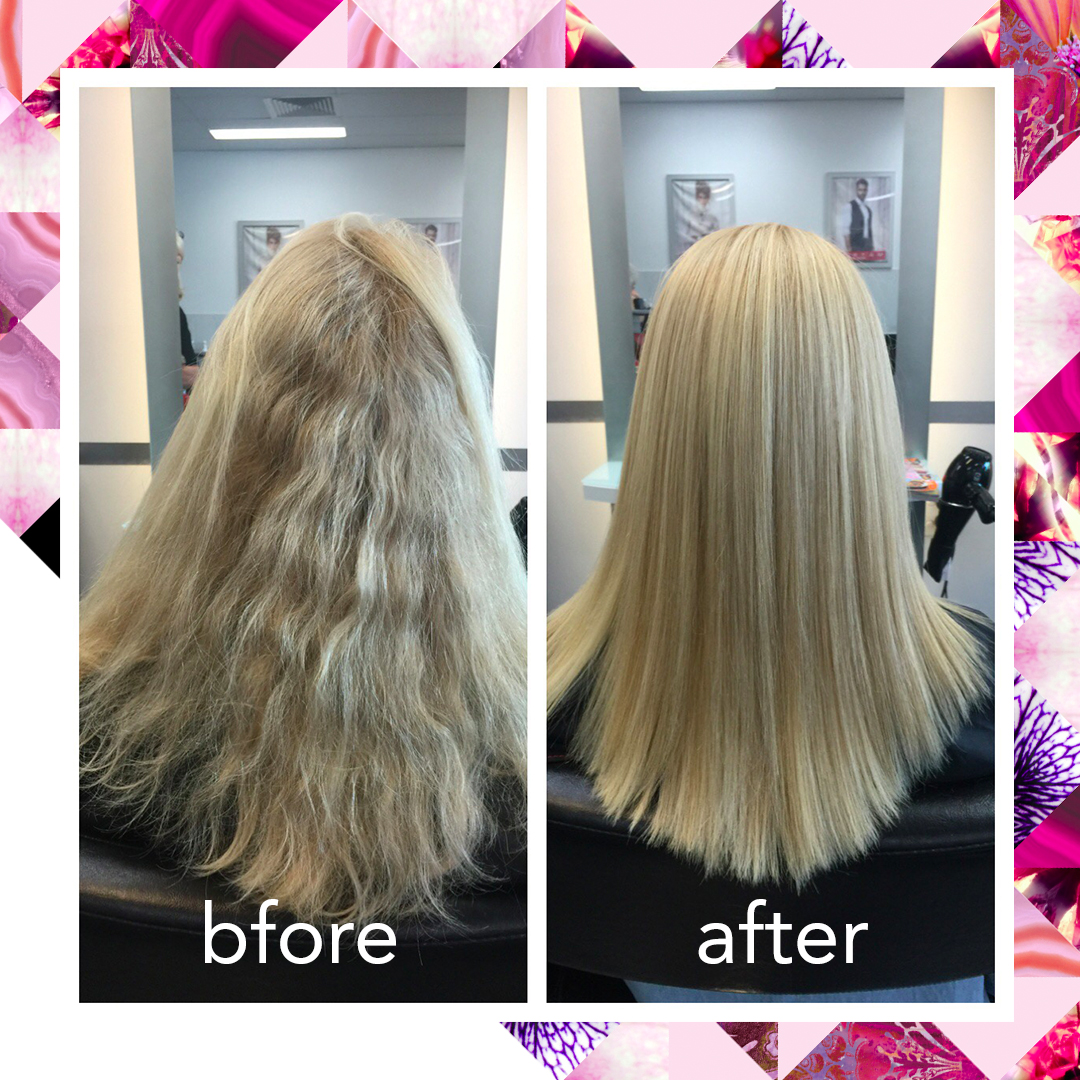
Permanent straightening treatments are hair-styling techniques that aim to eliminate frizz and achieve sleek, straight hair. These treatments involve the application of chemical solutions or heat to alter the hair’s structure, resulting in long-lasting straightness.
There are various types of permanent straightening treatments available, each with its own advantages and considerations.
Types of Permanent Straightening Treatments
The primary types of permanent straightening treatments include:
- Relaxers: Relaxers are chemical treatments that break down the hair’s bonds, allowing it to be reshaped and straightened. They are typically used on curly or coily hair.
- Japanese Straightening: Japanese straightening, also known as thermal reconditioning, involves a combination of chemical and heat treatments to achieve extremely straight hair. It is a long-lasting treatment that can last up to six months.
- Brazilian Blowout: Brazilian Blowout is a keratin-based treatment that smooths and straightens hair while reducing frizz. It is less permanent than other straightening methods and typically lasts up to three months.
- Thermal Straightening: Thermal straightening, also known as flat ironing, involves using a flat iron to straighten hair. While not permanent, thermal straightening can provide temporary straightness that lasts until the next wash.
Factors to Consider When Choosing a Permanent Straightening Treatment

Choosing a permanent straightening treatment requires careful consideration of several factors that influence the outcome and suitability of the treatment for your individual needs and hair characteristics. These factors include hair type, texture, condition, lifestyle, maintenance preferences, and potential risks and side effects.
Hair Type and Texture
Understanding your hair type and texture is crucial in determining the most appropriate permanent straightening treatment. Coarse, thick hair with tight curls typically requires stronger straightening solutions and techniques compared to fine, thin hair with looser waves. Different hair textures respond differently to straightening treatments, and choosing a treatment that aligns with your hair’s unique characteristics ensures optimal results.
Hair Condition
The condition of your hair plays a significant role in determining the suitability of a permanent straightening treatment. Damaged or fragile hair is more prone to breakage and adverse effects from chemical treatments. A thorough assessment of your hair’s health, including factors like porosity, elasticity, and past chemical treatments, helps ensure the treatment is safe and effective.
Lifestyle and Maintenance Preferences
Consider your lifestyle and maintenance preferences when choosing a permanent straightening treatment. If you lead an active lifestyle or frequently engage in activities that cause hair frizz or curl reversion, a treatment that provides long-lasting results and is low-maintenance might be ideal.
Additionally, consider your willingness to invest time and effort in maintaining the straightened hair, as some treatments require regular touch-ups or specific styling techniques.
Potential Risks and Side Effects
Permanent straightening treatments involve chemical processes that can potentially cause adverse effects on your hair and scalp. It is essential to be aware of these risks and side effects before making a decision. Common concerns include hair breakage, scalp irritation, dryness, and potential allergic reactions.
Discussing these risks with a qualified hairstylist or hair care professional can help you make an informed choice and take necessary precautions to minimize any potential adverse effects.
Popular Permanent Straightening Treatments
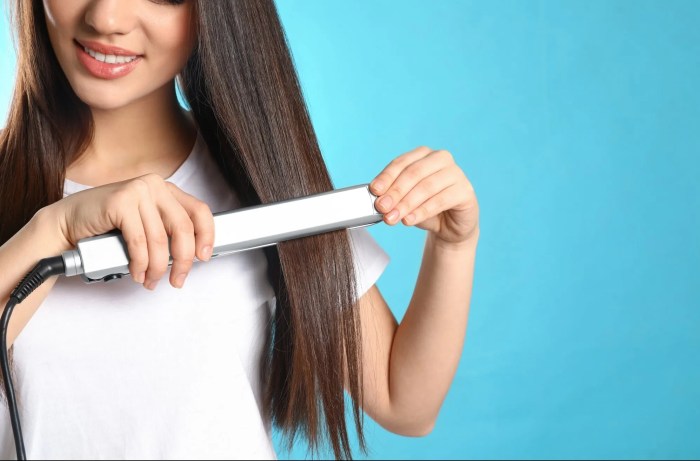
Permanent straightening treatments offer a solution for those seeking sleek, straight hair. However, with various options available, selecting the right treatment can be daunting. This comparative analysis provides insights into the most popular permanent straightening treatments, helping you make an informed decision.
Permanent straightening treatments work by altering the hair’s structure, breaking down the bonds that give it its natural curl or wave. Chemicals like formaldehyde, thioglycolate, and cysteine are commonly used to achieve this.
Treatment Comparison
The following table compares popular permanent straightening treatments based on treatment type, chemical composition, application process, and expected results:
| Treatment Type | Chemical Composition | Application Process | Expected Results |
|---|---|---|---|
| Japanese Straightening | Formaldehyde-based | Multi-step process involving multiple chemical applications and heat | Long-lasting, pin-straight results that can last up to 6 months |
| Brazilian Blowout | Formaldehyde-free, typically uses keratin or cysteine | Single-step application involving a smoothing solution and heat | Reduces frizz, adds shine, and provides a smoother, straighter appearance |
| Keratin Treatment | Formaldehyde-free, uses keratin protein | Single-step application involving a keratin solution and heat | Improves hair texture, reduces frizz, and adds shine, resulting in straighter, healthier-looking hair |
| Thermal Reconditioning | Uses heat and a conditioning agent | Multi-step process involving heat and a conditioning treatment | Temporary straightening that lasts up to a few weeks, suitable for mild waves or curls |
Each treatment has its own advantages and disadvantages:
- Japanese Straightening: Pros
– long-lasting results, suitable for all hair types. Cons
– can be harsh on hair, requires multiple chemical applications, and may cause damage if not done correctly. - Brazilian Blowout: Pros
– less damaging than Japanese straightening, reduces frizz, and adds shine. Cons
– results may not be as long-lasting, may require touch-ups every few months. - Keratin Treatment: Pros
– improves hair health, reduces frizz, and adds shine. Cons
– results may not be as straight as with other treatments, may require touch-ups every few months. - Thermal Reconditioning: Pros
– temporary straightening, less damaging than chemical treatments. Cons
– results may not be as long-lasting, suitable only for mild waves or curls.
DIY vs. Professional Permanent Straightening Treatments

Choosing between a DIY or professional permanent straightening treatment depends on various factors. Each approach has its own advantages and disadvantages.
DIY Permanent Straightening Treatments
Advantages:
- Cost-effective: DIY treatments are generally less expensive than professional services.
- Convenience: You can perform the treatment at home, saving time and travel.
- Control: You have complete control over the application process and the desired level of straightening.
Disadvantages:
- Risk of Damage: Improper application or the use of harsh chemicals can damage your hair, leading to breakage, dryness, and scalp irritation.
- Time-Consuming: DIY treatments can be lengthy and require careful attention to detail.
- Limited Options: DIY kits typically offer a limited range of straightening solutions, which may not be suitable for all hair types or desired results.
Professional Permanent Straightening Treatments
Advantages:
- Expertise: Professional hairstylists have the knowledge, skills, and experience to assess your hair type and recommend the most suitable straightening treatment.
- Safety: Professionals use high-quality products and techniques designed to minimize hair damage and ensure a safe and effective treatment process.
- Customization: Hairstylists can tailor the treatment to your specific hair needs, ensuring optimal results while preserving the health of your hair.
Disadvantages:
- Cost: Professional treatments are generally more expensive than DIY kits.
- Time Commitment: The treatment process may require multiple salon visits and can be time-consuming.
- Limited Availability: Not all salons offer permanent straightening services, and finding a qualified hairstylist may require research and recommendations.
Tips for Choosing a Qualified and Experienced Hairstylist
- Research: Look for salons and hairstylists specializing in permanent straightening treatments.
- Recommendations: Ask friends, family, or online reviews for recommendations of reputable hairstylists.
- Consultation: Schedule a consultation with the hairstylist to discuss your hair goals, hair type, and any concerns you may have.
- Experience: Inquire about the hairstylist’s experience in performing permanent straightening treatments and their knowledge of different hair types.
- Products: Ask about the products they use and their safety and effectiveness.
- Cost: Compare the cost of the treatment with other salons and hairstylists to ensure you are getting a fair price.
Pre-Treatment Care and Preparation
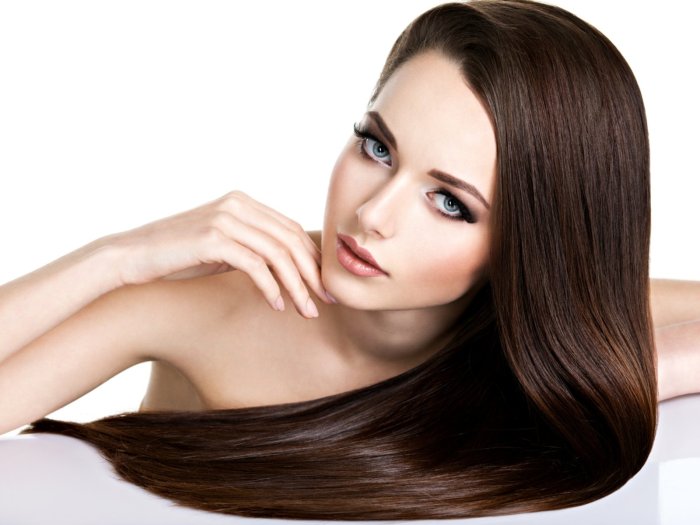
Preparing your hair for a permanent straightening treatment is crucial to achieving optimal results and minimizing potential damage. Proper pre-treatment care and preparation help ensure that your hair is healthy, strong, and ready to undergo the straightening process.
Deep Conditioning and Nourishment
Deep conditioning treatments provide intense hydration and nourishment to your hair, replenishing lost moisture and restoring its natural strength and elasticity. This is particularly important for hair that has been subjected to chemical treatments, heat styling, or environmental stressors, as these factors can strip away natural oils and leave hair dry, brittle, and more prone to breakage.
Apply a deep conditioning mask or treatment to your hair at least two weeks before the straightening treatment. Leave it on for the recommended duration, typically 30 minutes to an hour, to allow the nourishing ingredients to penetrate deeply into the hair shaft.
Rinse thoroughly and follow with a gentle shampoo and conditioner.
Avoiding Harsh Chemicals and Heat Styling
In the weeks leading up to the straightening treatment, avoid using harsh chemicals or heat styling tools on your hair. This includes chemical hair dyes, bleach, perms, and excessive heat from blow dryers, flat irons, or curling wands. These treatments can further weaken your hair and make it more susceptible to damage during the straightening process.
Instead, opt for gentle hair care products and styling techniques. Use a sulfate-free shampoo and conditioner, and air-dry your hair whenever possible. If you must use heat styling tools, apply a heat protectant spray to your hair before styling and use the lowest heat setting possible.
Step-by-Step Guide to Preparing Hair for a Permanent Straightening Treatment
- Two Weeks Before: Start deep conditioning your hair regularly, at least once a week.
- One Week Before: Avoid harsh chemicals, heat styling, and tight hairstyles that can stress your hair.
- Three Days Before: Wash your hair with a gentle sulfate-free shampoo and conditioner. Do not use any styling products.
- The Day Before: Avoid washing your hair. This allows your natural oils to accumulate and provide a protective barrier during the straightening process.
- On the Day of the Treatment: Arrive at the salon with your hair dry and free of any styling products.
During the Treatment

Once you’ve chosen a permanent straightening treatment and consulted a professional, it’s time to undergo the process. Here’s a comprehensive guide to the treatment process, from application to rinsing, along with tips to ensure optimal results and minimize damage.
Note: It’s crucial to follow the instructions provided by your stylist or the product manufacturer to ensure safety and effectiveness.
Step 1: Hair Preparation
Before applying the straightening solution, your hair will be thoroughly washed and cleansed using a clarifying shampoo to remove any product buildup or dirt. This ensures the solution can penetrate the hair shaft effectively.
Step 2: Application of the Straightening Solution
The straightening solution is applied section by section to dry hair, starting from the nape of the neck and working towards the front. A brush or comb is used to evenly distribute the solution throughout the hair, ensuring it saturates each strand.
Tip: Avoid getting the solution on your scalp, as it can cause irritation.
Step 3: Processing Time
Once the solution is applied, it’s left on the hair for a specific amount of time, as per the product instructions. This allows the solution to break down the hair’s natural bonds, enabling it to be straightened.
Tip: Processing time can vary depending on the product used and the condition of your hair. Follow the manufacturer’s instructions carefully to avoid over-processing, which can damage your hair.
Step 4: Rinsing and Neutralization
After the processing time is complete, the hair is thoroughly rinsed with water to remove the straightening solution. A neutralizing solution is then applied to stop the straightening process and restore the hair’s natural pH balance.
Tip: Rinse the hair thoroughly to ensure all traces of the straightening solution are removed. Failure to do so can cause scalp irritation or hair damage.
Step 5: Blow-Drying and Flat Ironing
Once the hair is rinsed and neutralized, it’s blow-dried and flat-ironed to achieve the desired straightness. The flat iron should be set to a temperature appropriate for your hair type.
Tip: Use a heat protectant spray before blow-drying and flat ironing to minimize heat damage.
Post-Treatment Care and Maintenance
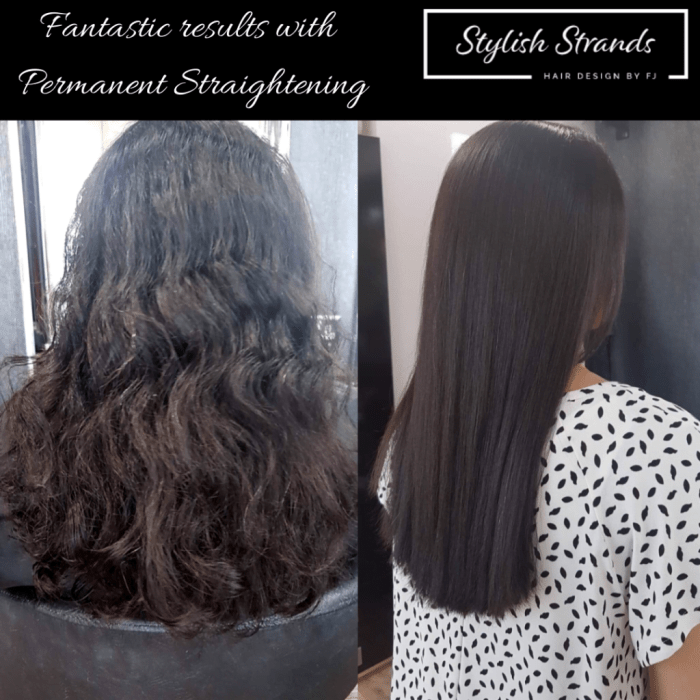
Ensuring the longevity and health of your newly straightened hair is paramount. Post-treatment care and maintenance are crucial to maintaining beautiful, healthy, and damage-free hair.
Following a dedicated hair care routine is essential to maintain the health and beauty of your permanently straightened hair. Here are some important considerations and recommendations to keep your hair looking its best:
Recommended Hair Care Products and Practices
- Use Sulfate-Free Shampoo and Conditioner: Opt for gentle, sulfate-free hair care products that are designed for chemically treated hair. These products help maintain the integrity of the straightening treatment and prevent color fading.
- Deep Conditioning: Incorporate deep conditioning treatments into your routine to replenish moisture and nutrients. Use deep conditioners specifically formulated for chemically treated hair to restore softness and shine.
- Avoid Heat Styling: Minimize the use of heat styling tools such as blow dryers, flat irons, and curling wands. If heat styling is necessary, use a heat protectant spray to minimize damage.
- Regular Trims: Schedule regular trims to remove split ends and prevent further breakage. This will help maintain the overall health and appearance of your hair.
- Protect from Sun Damage: Shield your hair from sun exposure by wearing a hat or scarf when outdoors. UV rays can cause color fading and dryness, especially for chemically treated hair.
Frequency of Touch-Ups and Signs of Hair Damage
The frequency of touch-ups depends on the type of permanent straightening treatment and the rate of hair growth. Generally, touch-ups are recommended every 3-6 months to maintain straight, frizz-free hair.
It is important to be aware of signs of hair damage that may indicate the need for a touch-up or a change in hair care routine. These signs include:
- Dryness and Brittleness: Chemically treated hair tends to be drier and more prone to breakage. If your hair feels dry and brittle, it may need additional moisture and conditioning.
- Split Ends: Split ends are a common sign of hair damage. Regular trims can help prevent split ends and maintain healthy hair growth.
- Loss of Shine: Chemically treated hair may lose its natural shine over time. Using products specifically designed for treated hair can help restore shine and vitality.
- Fading Color: Permanent straightening treatments can cause color fading. To maintain vibrant color, use color-safe hair care products and consider regular touch-ups.
By following these post-treatment care and maintenance tips, you can keep your permanently straightened hair healthy, beautiful, and manageable for longer.
Last Recap
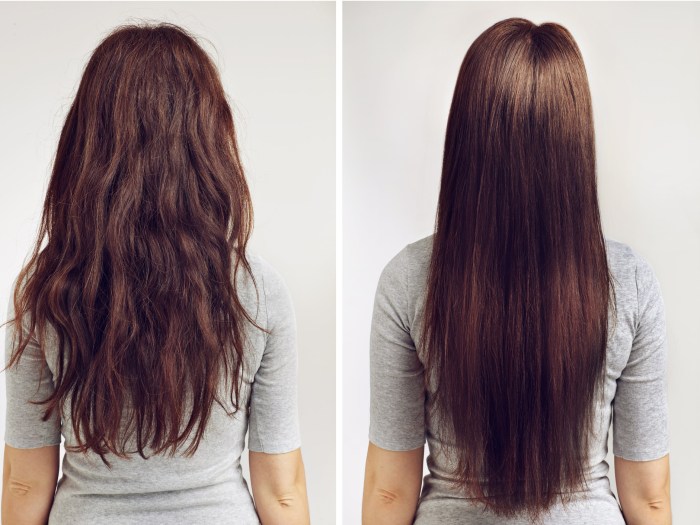
Choosing the right permanent straightening treatment is a personal decision that depends on various factors. By carefully considering hair type, texture, and condition, as well as lifestyle and maintenance preferences, individuals can make an informed choice that aligns with their hair goals.
It is important to remember that permanent straightening treatments can be harsh on hair, so proper pre- and post-treatment care is crucial to maintain healthy, beautiful hair.
FAQ Corner
What are the benefits of permanent straightening treatments?
Permanent straightening treatments offer several benefits, including reduced styling time, easier maintenance, improved manageability, and a sleek, polished look.
How long do permanent straightening treatments last?
The longevity of permanent straightening treatments varies depending on the type of treatment, hair type, and maintenance routine. Generally, chemical straightening treatments can last up to 6 months, while thermal straightening treatments may last up to 3 months.
Can permanent straightening treatments damage hair?
Permanent straightening treatments can potentially damage hair if not done properly or if proper care is not taken before and after the treatment. Chemical straightening treatments, in particular, can cause dryness, breakage, and scalp irritation if not applied correctly.
What are some alternatives to permanent straightening treatments?
There are several alternatives to permanent straightening treatments, including semi-permanent straightening treatments, heat styling tools, and natural hair care methods. Semi-permanent straightening treatments offer a less drastic option that lasts for a few weeks, while heat styling tools can be used to achieve temporary straightening.

